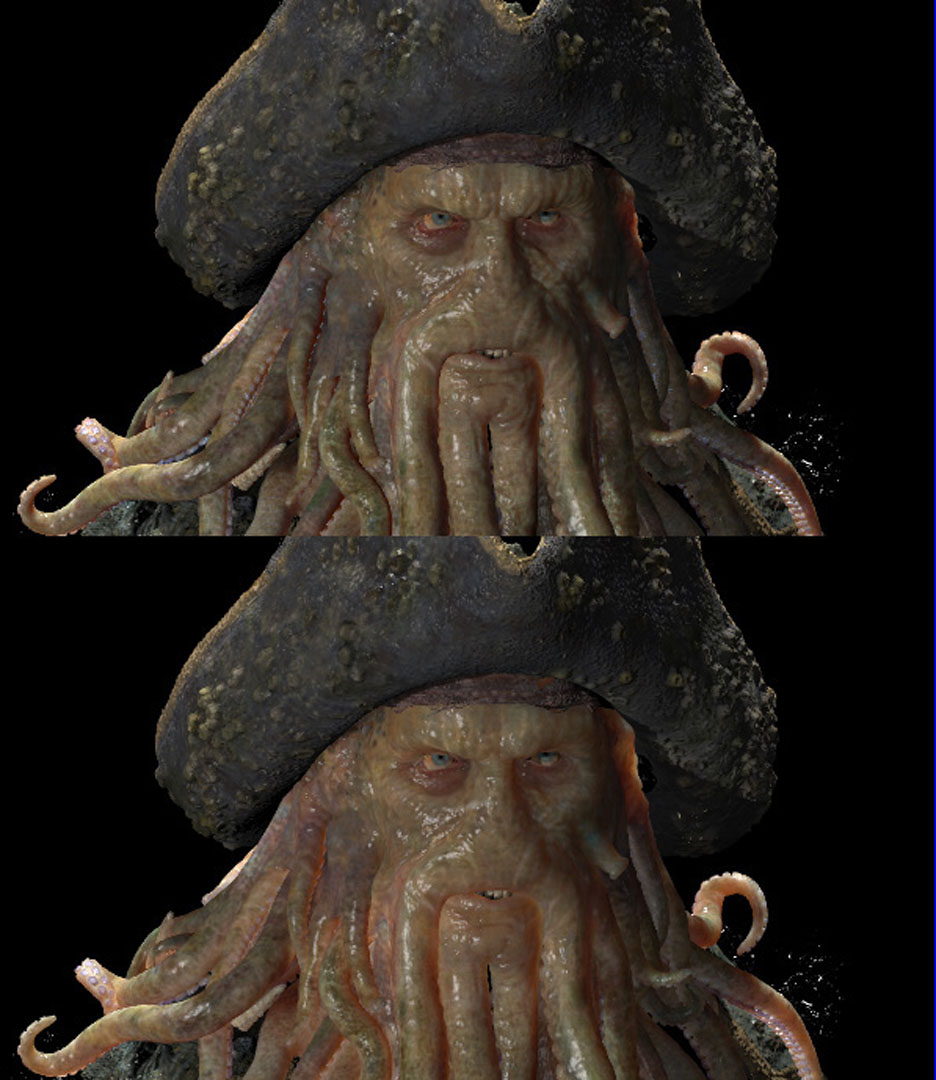“The lightspeed automatic interactive lighting preview system” by Ragan-Kelley, Kilpatrick, Smith, Epps, Green, et al. …
Conference:
Type(s):
Title:
- The lightspeed automatic interactive lighting preview system
Presenter(s)/Author(s):
Abstract:
We present an automated approach for high-quality preview of feature-film rendering during lighting design. Similar to previous work, we use a deep-framebuffer shaded on the GPU to achieve interactive performance. Our first contribution is to generate the deep-framebuffer and corresponding shaders automatically through data-flow analysis and compilation of the original scene. Cache compression reduces automatically-generated deep-framebuffers to reasonable size for complex production scenes and shaders. We also propose a new structure, the indirect framebuffer, that decouples shading samples from final pixels and allows a deep-framebuffer to handle antialiasing, motion blur and transparency efficiently. Progressive refinement enables fast feedback at coarser resolution. We demonstrate our approach in real-world production.
References:
1. Alias, 1999. Interactive photorealistic rendering.Google Scholar
2. Andersen, P. H. 1996. Partial evaluation applied to ray tracing. In Software Engineering in Scientific Computing, Vieweg, W. Mackens and S. Rump, Eds., 78–85.Google Scholar
3. Apodaca, A. A., and Gritz, L. 2000. Advanced RenderMan: creating CGI for motion pictures. Morgan Kaufmann. Google ScholarDigital Library
4. Bleiweiss, A., and Preetham, A. 2003. Ashli—Advanced shading language interface. ACM SIGGRAPH Course Notes.Google Scholar
5. Cook, R. L., Carpenter, L., and Catmull, E. 1987. The reyes image rendering architecture. In Computer Graphics (Proceedings of SIGGRAPH 87), 95–102. Google ScholarDigital Library
6. Dorsey, J., Arvo, J., and Greenberg, D. 1995. Interactive design of complex time dependent lighting. IEEE Computer Graphics & Applications 15, 2 (Mar.), 26–36. Google ScholarDigital Library
7. Gershbein, R., and Hanrahan, P. M. 2000. A fast relighting engine for interactive cinematic lighting design. In Proceedings of ACM SIGGRAPH 2000, Computer Graphics Proceedings, Annual Conference Series, 353–358. Google ScholarDigital Library
8. Guenter, B., Knoblock, T. B., and Ruf, E. 1995. Specializing shaders. In Proceedings of SIGGRAPH 95, Computer Graphics Proceedings, Annual Conference Series, 343–350. Google ScholarDigital Library
9. Hanrahan, P. 1983. Ray tracing algebraic surfaces. In Proc. of SIGGRAPH 1983, 83–90. Google ScholarDigital Library
10. Hašan, M., Pellacini, F., and Bala, K. 2006. Direct-to-indirect transfer for cinematic relighting. ACM Transactions on Graphics 25, 3 (July), 1089–1097. Google ScholarDigital Library
11. Horwitz, S., Reps, T., and Binkley, D. 1990. Interprocedural slicing using dependence graphs. ACM Transactions on Programming Languages and Systems 12, 1, 26–60. Google ScholarDigital Library
12. Jensen, H. W., and Buhler, J. 2002. A rapid hierarchical rendering technique for translucent materials. ACM Transactions on Graphics 21, 3 (July), 576–581. Google ScholarDigital Library
13. Jones, T. R., Perry, R. N., and Callahan, M. 2000. Shadermaps: a method for accelerating procedural shading. Tech. rep., Mitsubishi Electric Research Laboratory.Google Scholar
14. Knoblock, T. B., and Ruf, E. 1996. Data specialization. In Proc. of SIGPLAN 1996, 215–225. Google ScholarDigital Library
15. Mark, W. R., Glanville, R. S., Akeley, K., and Kilgard, M. J. 2003. Cg: A system for programming graphics hardware in a C-like language. ACM Transactions on Graphics 22, 3 (July), 896–907. Google ScholarDigital Library
16. Mogensen, T. 1986. The application of partial evaluation to raytracing. Master’s thesis, DIKU, U. of Copenhagen, Denmark.Google Scholar
17. Ng, R., Ramamoorthi, R., and Hanrahan, P. 2003. All-frequency shadows using non-linear wavelet lighting approximation. ACM Transactions on Graphics 22, 3 (July), 376–381. Google ScholarDigital Library
18. Nvidia, 2005. Sorbetto relighting technology.Google Scholar
19. Peercy, M. S., Olano, M., Airey, J., and Ungar, P. J. 2000. Interactive multi-pass programmable shading. In Proceedings of ACM SIGGRAPH 2000, Computer Graphics Proceedings, Annual Conference Series, 425–432. Google ScholarDigital Library
20. Pellacini, F., Vidimče, K., Lefohn, A., Mohr, A., Leone, M., and Warren, J. 2005. Lpics: a hybrid hardware-accelerated relighting engine for computer cinematography. ACM Transactions on Graphics 24, 3 (Aug.), 464–470. Google ScholarDigital Library
21. Pellacini, F. 2005. User-configurable automatic shader simplification. ACM Transactions on Graphics 24, 3 (Aug.), 445–452. Google ScholarDigital Library
22. Pixar, 2001. Irma.Google Scholar
23. Ragan-Kelley, J. 2007. The Lightspeed Automatic Interactive Lighting Preview System. Master’s thesis, Massachusetts Institute of Technology.Google Scholar
24. Reps, T., Horwitz, S., and Sagiv, M. 1995. Precise interprocedural data flow analysis via graph reachability. In Proc. of SPPL 1995, 49–61. Google ScholarDigital Library
25. Saito, T., and Takahashi, T. 1990. Comprehensible rendering of 3-d shapes. In Computer Graphics (Proceedings of SIGGRAPH 90), 197–206. Google ScholarDigital Library
26. Séquin, C. H., and Smyrl, E. K. 1989. Parameterized ray tracing. In Computer Graphics (Proceedings of SIGGRAPH 89), 307–314. Google ScholarDigital Library
27. Sloan, P.-P., Kautz, J., and Snyder, J. 2002. Precomputed radiance transfer for real-time rendering in dynamic, low-frequency lighting environments. ACM Transactions on Graphics 21, 3 (July), 527–536. Google ScholarDigital Library
28. Tabellion, E., and Lamorlette, A. 2004. An approximate global illumination system for computer generated films. ACM Transactions on Graphics 23, 3 (Aug.), 469–476. Google ScholarDigital Library
29. Wexler, D., Gritz, L., Enderton, E., and Rice, J. 2005. Gpu-accelerated high-quality hidden surface removal. In Graphics Hardware 2005, 7–14. Google ScholarDigital Library





